Starhawk Review
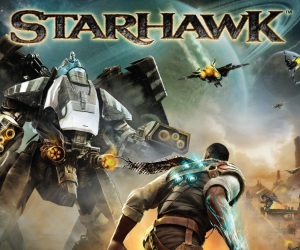 Game: Starhawk
Game: Starhawk
Developers: LightBox Interactive
Publisher: Sony Computer Entertainment
Available on: PlayStation 3 only
Of all the slightly dubious design choices in Starhawk, perhaps the most unfortunate is Emmett Graves’ scarf. For some reason, he is decked out in an outfit almost identical to that sported by Nathan Drake in the iconic desert publicity shots for Uncharted 3. It’s likely that thousands of Starhawk discs will be slid into PlayStation 3 consoles decked out in vinyls displaying Emmett’s scarf, except it’s not worn by Emmett, it’s slung across the shoulders of a man who not only handles numerous firearms with aplomb, but scales spectacular environments with ease, amuses all and sundry with his witty banter, and always gets the girl.
By comparison, poor Emmett suffers. He handles firearms so awkwardly that auto-targeting is a sad necessity, spends ages tramping across featureless environments, seems to have lost his personality in the same accident that made his eyes go all glowy, and pretty much the only girl he knows is hung up on his brother.
Which is all a bit of a shame, because I really wanted to like Starhawk. It’s an ambitious combination of third-person shooter and real-time strategy (a TPSRTS, which, co-incidentally, is the noise I made every time I found myself having to repeat one of the game’s preposterously long checkpoints, of which more later) set in a refreshingly colourful Wild West in outer space. Though combining strategy with action in this way is not unheard of, it’s not that common either, and the epic multiplayer certainly makes it worthy of attention and scrutiny before dismissal.
STORY: Emmett Graves is a gruff and humourless “gunslinger”, a kind of freelance space-cowboy hired by various angsty farmers to rid them of scabs. No, not the crusty kind, but ex-humans, forever transformed into glowing zombies following overexposure to “Rift Energy”. They’re technically known as “Outcasts”, but Emmett, his chum-with-an-eye-patch Cutter and everyone they meet on their journey refers to them as “scabs”.
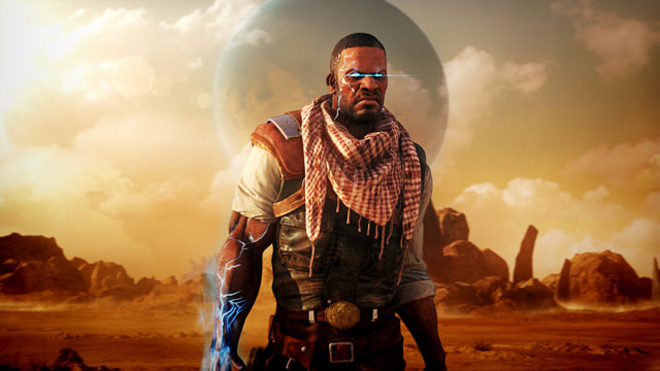
Anyway, every gruff and humourless action hero needs a back story to explain how he got to be so gruff and humourless, and Emmett’s involves overexposure to Rift Energy. He was saved from scab-dom by Cutter, who installed a “regulator” into his spine to prevent him from being overwhelmed by the Rift Energy which will remain a part of him for the rest of his life. Despite the relative success of Cutter’s efforts, Emmett’s condition renders him an outcast, condemned to spending the rest of his life picking off scabs for money. The plot, for want of a better word, is largely driven by the fact that the accident which turned Emmett into a human glow-stick also turned his brother Logan into a marauding Outcast. You can probably guess how things turn out.
While Cutter demonstrates flickers of personality (even if he starts repeating lines of exposition every ten seconds whenever you have the temerity to explore), Emmett has none. He’s one of millions of game heroes doomed to life as a pariah by the very incident that gave him his power, so you’d think he’d make a bit more effort to distinguish himself, but no. He was created by the Random Cynical Video Game Protagonist Generator (TM) and dressed in Nathan Drake’s sweaty cast-offs.
Worse is the fact that the game’s universe is shallow and lifeless. The action takes place on maps, rather than in environments, and without any detail, character or humanity evident in the design, it is impossible to immerse you in a world where human beings carve out a living. For some reason, NPCs are given names, but you soon realise they’re no more than a commodity, existing only to be spawned at your whim and send them off into battle. This is frustrating, because there’s tremendous potential in the space-western setting to cast these people as pioneers carving out a living on the frontier of society. However, the opportunity is wasted, and there is never a sense that theirs is a way of life worth saving.
The game has clearly been designed around multiplayer (we’re getting to that), but that’s no excuse for including such an anaemic single-player mode. We’re now in a world where most shooter campaigns provide elaborate training for online frag-fests, so perhaps the majority of people who buy Starhawk will do so with scant regard for the story. I do hope so, because anyone hoping for a satisfying single-player will be sorely disappointed.
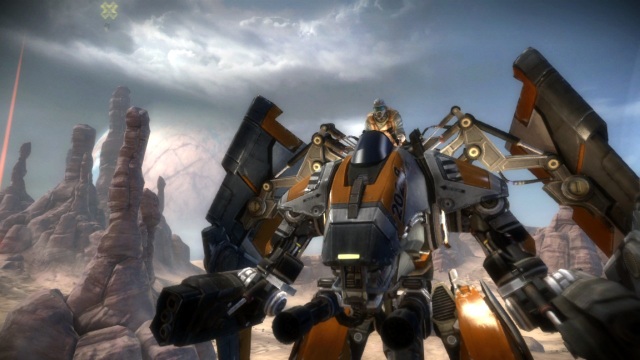
GRAPHICS: We learn about Emmett, Cutter, Logan and the rest through a series of animated cutscenes similar to those in Mirror’s Edge. They were distancing in that game and they’re distancing here, putting a clear barrier between the Emmett who is all stressed out by his brother and the Emmett you control in-game. They’re certainly not the worst narrative device in the game however, and it’s hard to begrudge them when they were probably chosen as an economical alternative to in-engine cutscenes.
The aforementioned lack of detail aside, level design is attractive enough. There is never any reason to explore (though there is a useful option to wander around multiplayer maps outside battle to get the lay of the land), but then the gameplay doesn’t really demand it. Although at first, the environments bring to mind the colourful wastes of Borderlands in much the same way as Emmett’s scarf invites unfavourable comparisons with another bloke in a grubby T-shirt, you soon realise that an arena’s peaks, troughs and plateaus are more important than its buildings and its character. Bland, yes, but functional.
SOUND: The voice acting is persistently average, but there’s not much even the best actors could do to make the script interesting. Music is better, mixing the steel-stringed guitars of the wild west with the orchestral pomp of a thousand science-fiction epics. It’s nothing especially ground-breaking, but at least it creates a sense of place.
GAMEPLAY: So, how does this combination of third-person shooter and real-time strategy actually play? Generally, it’s fair to say that the RTS holds up rather better than the TPS. The shooting feels weightless and insubstantial, a fact made manifest by the magnetic target assist. It’s tactically hollow as well, because not only can you carry all guns at once, but ammo boxes (dropped by fallen enemies) refill all weapons. Consequently, you never have to put much thought into which weapon to use when.
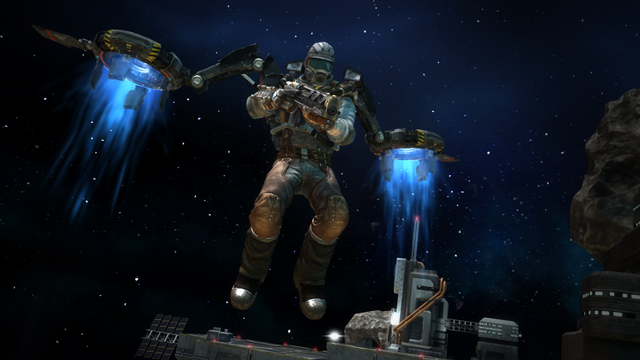
With the exception of the sniper rifle and the shotgun, not even range will pay much part in your decision: the assault rifle will happily rip up just about anything you can lay your eyes on. Considering how important strategy is supposed to be to this game, it’s a shame that the decisions you make when shooting are so utterly arbitrary.
The real-time strategy portion of the game fares better. While Emmett runs around on the planet’s (or space station’s) surface, Cutter is up in the sky, ready to drop down turrets, outposts, supply bunkers, launch platforms and more at Emmett’s request. Once you’ve got over how silly the premise is from a logical perspective and remember that you’re playing a video game, this becomes intuitive and fun.
For the first few levels of the single-player mode, there’s not a lot of strategy involved because you only have a few structures to choose from, but later on, and in multiplayer, you’ll have to erect walls to protect crucial structures, build launch platforms for vehicles (both ground and air-based), spawn allies to control them and call down repair stations to fix them.
There’s barely any time between calling down a structure and it appearing fully-functional in front of you, so don’t have to think too far ahead when planning your strategy. Likewise, the “currency” for building structures is the aforementioned Rift Energy, which you get from killing enemies or destroying (respawning) barrels. Though your building power is limited by your store of Rift Energy, finding more is simply a case of mowing down stragglers or whizzing over to an unused structure on a vehicle and reclaiming it for some of the Rift Energy it cost to build.
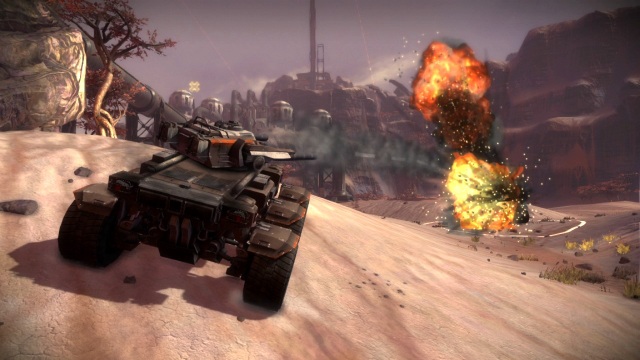
Straddling the gap between the strategy and the shooting are the vehicle sections. Depending on the environment, you might be riding Sidewinders (a kind of jet bike), Razorbacks (jeeps) Vultures (jetpacks) or Hawks, which are a bit like controlling Starscream in a Transformers game, except without the amusing voice. Hawks will either be a high point of the game or something to dread, depending on your general feelings towards 1990s console dogfighters, since they’re almost exclusively used to pick off enemy starfighters in a video game version of zero gravity devoid of any kind of physics using a pretty tired arsenal of homing missiles, targeted lasers and cluster bombs.
That said, if you find the flying mechanics too tedious, you can always just spawn a group of NPCs to take to the skies for you. And that’s really the answer to any complaint you might have about Starhawk, at least once you’ve made it though the first few levels of the campaign. This is a strategy game, so if there’s an aspect of the game you don’t like, you can either find a way around it or get a bunch of dweebs to do it for you.
Or at least you could if they weren’t so stupid. The pathfinding for NPCs is pretty terrible, which is especially irritating when you need one of them to drive a vehicle for you. Bad AI also manages to turn single-player from a true RTS into a kind of tower defence game, since enemies often abandon teamwork and strategy, choosing instead to barrel blindly towards the structures you’re required to protect.
Single player’s other big problem is the checkpoints, which are a massive pain, since they’re not actually placed at the end of every battle. A gaming convention has emerged over the last decade whereby once you’ve cleared a field of enemies to the point where an objective is complete and control is taken away for you for a cutscene or some exposition, you don’t have to fight those enemies again. It’s emerged because it makes sense, and bucking against it for the sake of wringing another hour out of a weak campaign does not make a game inventive, it makes it sadistic. There is nothing more irritating then having to slog through a repetitive 20-minute space-battle again just because you made a strategic error at the beginning of the dust-up that follows it.
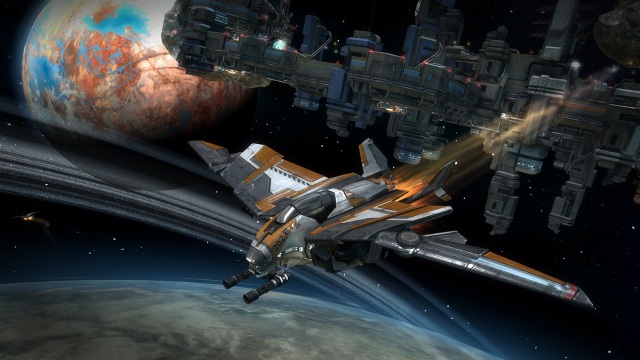
MULTIPLAYER: Multiplayer is altogether more complicated and more fun than the single-player. Though this isn’t hard, a few hours of online or co-op play should start to blur the painful memories of the “story”.
The most interesting modes are those which require teams to invade each others’ territories, such as Capture the Flag. This is because you’re forced to mount an attack while planning your defense and not simply set up a chain of defenses as you would against a monoric AI. Deciding how to fortify your area while making use of vehicles to plunder that of the other team is actually quite a challenge, and considerably more so if you don’t have a headset. Starhawk really does require effective teamwork, and the ability to communicate with your teammates is vital if you really want to get the most out of it.
Co-operative modes which see you face off against waves of enemies are more interesting than single-player versions of the same, but you’re still playing a larger, messier and less addictive version of iOS classic Fieldrunners.
LONGEVITY: There’s enough life and freedom in multiplayer to keep you happy for a while, and that’s where the Starhawk action’s likely to end up. There’s a lot of scope for levelling and character customisation, so those addicted to the opium of online XP will find plenty of ways to get their fix here. Those who enjoy the sense of camaraderie that clan-based gaming brings will also appreciate the potential for strategic teamwork that Starhawk brings.
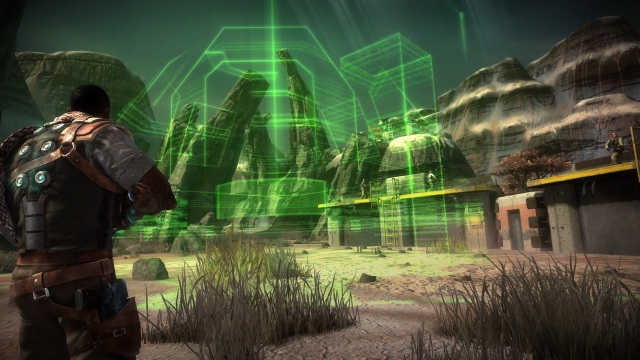
VERDICT: If enjoyably chaotic multiplayer is what you’re after, Starhawk’s a good bet, even if a headset is probably a necessity for anyone who wants to devote serious time to it. The PlayStation 3 has been crying out for a few more great multiplayer games and Starhawk fits the bill nicely. The shooting may be a little sloppy and the environments a tad sterile, but that’s made up for by the wealth of match options and the potential for teamwork and creative strategy.
Still, it’s hard to remain completely sanguine when the single player mode is so bad. The game’s official website boasts a “full single-player campaign” (above the references to multiplayer and co-op, if you want to get pedantic about it), but for a game so clearly designed around the multiplayer, that statement is at best creative, if not downright disingenuous. Perhaps it’s because online gaming on consoles has only really existed for a decade or so, but there still seems to be something taboo about a releasing a game on a console that’s solely multiplayer.
There are still many gamers uninterested in or unable to play muliplayer games, and they shouldn’t be led to believe that they’ll find anything of interest in Starhawk. There is absolutely nothing to recommend the tedious and dated campaign as an experience alone, and it provides the strongest argument I’ve yet seen for dispensing with the formalities of a plot for games that don’t need it and instead providing a set of focussed tutorials instead.





